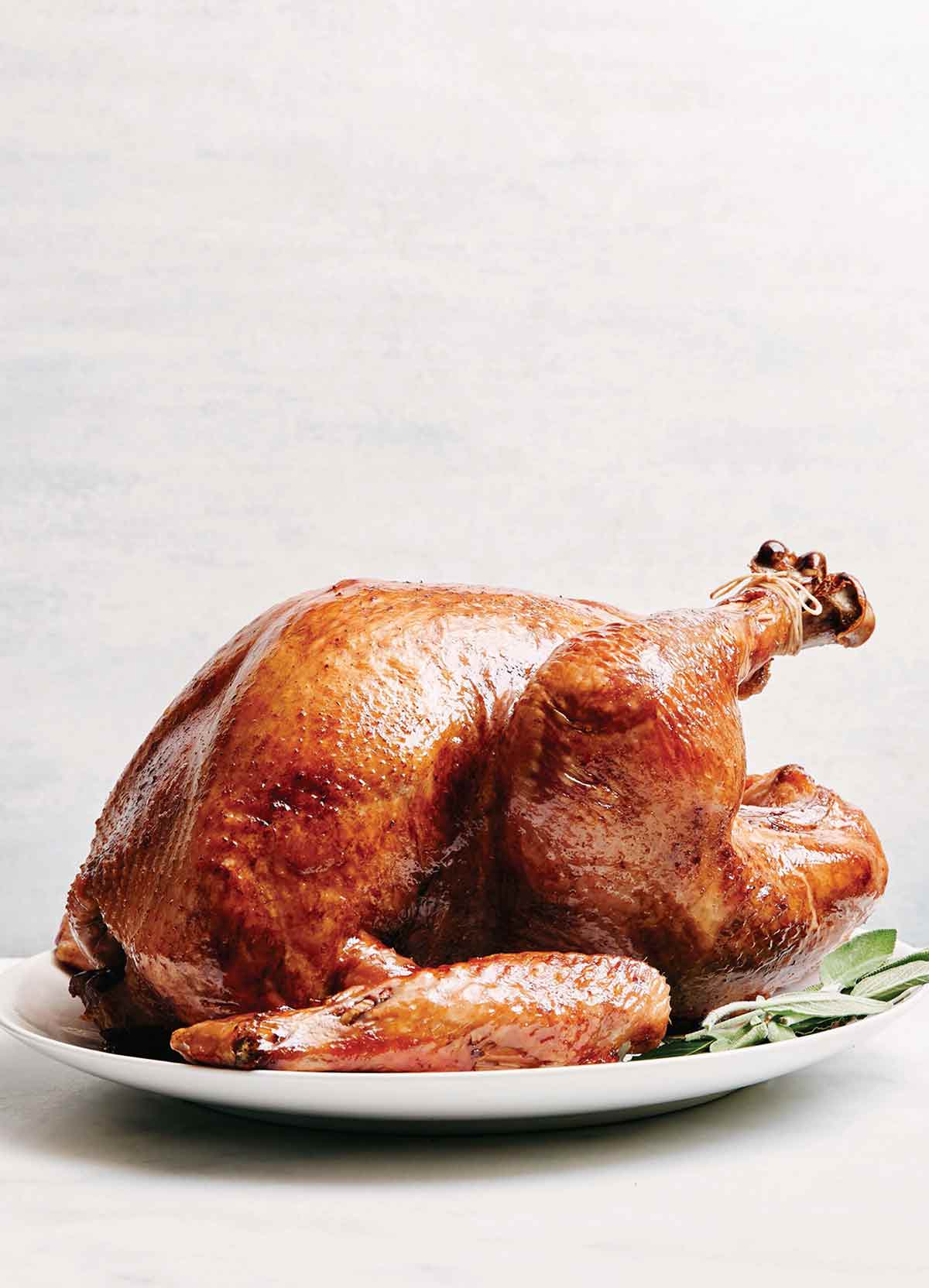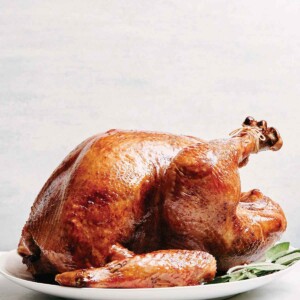This dry brine turkey gets blanketed in a salt and sugar rub overnight and is then rinsed and roasted until golden. The result? Perfectly moist and tender turkey. No basting required.

Adapted from Claire Tansey | Uncomplicated | Penguin Canada, 2018
It’s hard not to love the tender juiciness that brining a turkey coaxes into existence. But it’s not hard to feel daunted by the thought of finding a large enough container to hold all that brine plus a bird and somehow make space for that in your fridge which is already crammed full. Try the nifty little trick known as dry brining. And as the name implies, it achieves the same tremendous effects as regular wet brining but with virtually no effort, fuss, or fridge overwhelm.
As to why dry brining works, it’s a little complicated and has to do with stuff you learned in seventh-grade science class. But even if you don’t understand it, what you will understand, in the words of the recipe’s author and in our experience, is the reaction you’ll get from guests when you serve this bird. Hands-down, it’s the best turkey they’ll have ever eaten. It’s turkey magic.–Angie Zoobkoff
Dry Brine Turkey FAQs
It is absolutely critical that you use kosher salt, preferably Diamond Crystal brand, for this dry brine turkey recipe. Trust us. Regular salt is too fine and will permeate the fibers of the turkey and you’ll be unable to rinse it off, ruining your bird.
Using this salt and sugar dry brine, it needs at least 24 before you plan to put it in the oven, and up to 36 hours. Remember, the larger a piece of meat is, the longer it needs to brine. And remember to add in any time you might need to thaw your turkey before you start brining!
For this recipe, you’re going to have to go with a natural turkey. You won’t be able to use either a kosher or a pre-basted turkey because they’re both already pre-salted. Adding a dry brine is just going to put more salt into that poor turkey, so stick with a natural turkey.
Dry Brine Turkey

Ingredients
- 3 cups packed light brown sugar
- 1 1/2 cups Diamond brand kosher salt* (if you are using a different brand of kosher salt, you’ll want to weigh out 270 g)
- One (13-to-15-pound) fresh turkey
- 1 bunch fresh thyme parsley or sage, or a combination
- 3 tablespoons mild vegetable oil
Directions
- In a medium bowl, combine the brown sugar and kosher salt. Place the turkey in a large plastic bag and place the bag in a roasting pan.
- Pack the sugar mixture all over the breast, legs, and wings of the turkey, pressing firmly so as much of the mixture sticks as possible. Carefully close the bag, just for neatness’ sake, and then pop it into the fridge for 24 to 36 hours.
- About 4 hours before you plan to serve the turkey, preheat the oven to 325°F (165°C).
- Take the turkey out of the bag and rinse it under cold running water, gently rubbing it until every last speck of the brining mixture comes off. Don’t forget to rinse out the inside, too. It’s okay if the turkey looks a little dry. Trust us on this one.
- Place the turkey on a rack in a roasting pan and dry it with paper towels. Place the thyme in the cavity and tie the legs together with twine. Bend and tuck the wing tips under the back. Brush the turkey all over with the oil.
- Roast until a thermometer inserted into the thickest part of the thigh reads 175°F (80°C), 3 to 3 1/2 hours. Transfer the turkey to a carving board and tent loosely with foil. Let rest at least 30 minutes and as much as an hour before carving.
Show Nutrition
Recipe Testers’ Reviews
I’m very happy I invited company over to try this recipe because it was amazing. The turkey was perfectly seasoned and incredibly juicy with gorgeous, crisp skin.
I coated a 12.8-lb Butterball in the dry brine mixture for 24 hours. Since I used Morton’s sea salt, I weighed out 270 g. There was some brine left over, but my turkey was on the small side, so I think the recommended amount is perfect.
There was no specification about placing any brine inside the turkey cavity, so I just sprinkled a little bit in there. I followed the rest of the recipe, using both sage and thyme, and then placed the turkey in the lower third of my oven. Initially, the lack of basting instructions puzzled and confused me. I checked on the turkey after 90 minutes and it was browning nicely. I loitered around the kitchen for another 90 minutes, continuously peering through the oven window as I was quite sure the turkey would begin to look dry. After 3 hours, the turkey was a gorgeous bronze color and perfectly cooked. I removed the turkey from the oven and covered it loosely with foil for one hour. I grew up in a one-oven home, so this hour was standard because we needed to cook all the side dishes after removing the bird from the oven.
I served it with my great-grandmother’s oyster dressing and homemade gravy. I can’t wait to impress my family with this on Thanksgiving! With no need to baste, I can literally throw this bird in the oven and forget about it, which essentially gives me back three hours of my life. I don’t care who you are—that’s priceless.
Extremely delicious and moist. It’s much easier to dry brine than wet brine, that’s for sure.
I brined the bird for 26 hours using Diamond Kosher salt. At first, I was a bit worried because the turkey looked very dry, almost desiccated, but it ended up being perfect. The cook time was accurate. We served 7 people, with all the traditional Thanksgiving fare, and had plenty of leftovers for sandwiches and jook.
Originally published December 22, 2018


